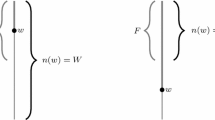Abstract
Several constructive description logics,12) in which classical negation was replaced by strong negation as a component to treat negative atomic information have been proposed as intuitionistic variants of description logics. For conceptual representation, strong negation alone and in a combination with classical negation seems to be useful and necessary due to their respective predicate denial (e.g., not happy) and predicate term negation (e.g., unhappy) properties. In this paper, we propose an alternative description logic \({\mathcal{ALC}}_{~}^{n}\) with classical negation and strong negation. We adhere in particular to the notions of contraries, contradictories, and subcontraries (as discussed in 6)), generated from conceivable statement types using predicate denial and predicate term negation. To capture these notions, our formalization includes a semantics that suitably interprets various combinations of classical negation and strong negation. We show that our semantics preserves contradictoriness and contrariness for \({\mathcal{ALC}}_{~}^{n}\)-concepts, but the semantics of constructive description logic \({\mathcal{CALC}}_{~}^{2}\) with Heyting negation and strong negation cannot preserve the property for \({\mathcal{CALC}}_{~}^{2}\)-concepts.
Similar content being viewed by others
References
Akama, S., “Constructive predicate logic with strong negation and model theory,” Notre Dame Journal of Formal Logic, 29(1), pp. 18-27, 1988.
Donini, F.M., “Complexity of reasoning,” in Description Logic Handbook, pp. 96-136, 2003.
Halpern, J. Y. and Moses, Y., “A guide to completeness and complexity for model logics of knowledge and belief,” Artificial Intelligence, 54(3), pp. 319-379, April 1992.
Herre, H., Jaspars, J. and Wagner, G., “Partial logics with two kinds of negation as a foundation for knowledge-based reasoning,” in What is Negation (Gabbay, D.M. and Wansing, H. eds.), pp. 121-159, Kluwer Academic Publishers, 1999.
Hollunder, B., Nutt, W. and Schmidt-Scha, “Subsumption algorithms for concept description languages,” in Proc. of ECAI-90, 9th European Conf. on Artificial Intelligence, pp. 348-353, 1990.
Horn, L. R., A Natural History of Negation, University of Chicago Press, 1989.
Horrocks, I. and Sattler, U., “Ontology reasoning in the SHOQ(D) description logic,” in Proc. of the Seventeenth Int. Joint Conf. on Artificial Intelligence, 2001.
Kaneiwa, K, “Negations in description logic - contraries, contradictories, and subcontradictories,” in Proc. of the 13th Int. Conf. on Conceptual Structures (ICCS ’05), Kassel University Press, 2005.
Kaneiwa, K., “On the semantics of classical first-order logic with constructive double negation,” in Proc. of the 2nd Indian Int. Conf. on Artificial Intelligence, 2005.
Kaneiwa, K. and Tojo, S., “An order-sorted resolution with implicitly negative sorts,” in Proc. of the 2001 Int. Conf. on Logic Programming, LNCS 2237, pp. 300-314, Springer-Verlag, 2001.
Nelson, D., “Constructible falsity,” The Journal of Symbolic Logic, 14(1), pp. 16-26, 1949.
Odintsove, S. P. and H. Wansing, “Inconsistency-tolerant description logic. motivation and basic systems,” in, Trends in Logic. 50 Years of Studia Logica, (Hendricks, V and Malinowski, J. eds), pp. 301-335. Kluwer Academic Publishers, 2003.
Ota, A., Hitei No Imi (in Japanese). Taishukan, 1980.
Pearce, D. and Wagner, G., “Logic programming with strong negation,” in Proc. of Int. Workshop on Extensions of Logic Programming, Tübingen, FRG, December 8-10 1989, LNAI, 475 (Schroeder-Heister, P. ed.), pp. 311-326,. Springer-Verlag.
La Palme Reyes, M., Macnamara, J., Reyes, G. E. and Zolfaghari, H., “Models for non-boolean negations in natural languages based on aspect,” in What is Negation? (Gabbay, D. M. and Wansing, H. eds.), pp. 241-260. Kluwer Academic Publishers, 1999.
Schmidt-Schauss, M. and Smolka, G., “Attributive concept descriptions with complements,” Artificial Intelligence, 48, pp. 1-26, 1991.
Thomason, R. H., “A semantical study of constructible falsity,” Zeitschrift für Mathematische Logik und Grundlagen der Mathematik, 15, pp. 247-257, 1969.
Wagner, G., “A database needs two kinds of negation,” in Mathematical Foundations of Database Systems (Thalheim, B, Demetrovics, J. and Gerhardt, H-D. eds.), LNCS 495 pp. 357-371, Springer Verlag, 1991.
Wagner, G., Vivid Logic: Knowledge-Based Reasoning with Two Kinds of Negation, Springer-Verlag, 1994.
Wansing, H., The logic of information structures, LNAI, 681, Springer Verlag, 1993.
Wansing, H. “Negation,” in The Blackwell Guide to Philosophical Logic (Goble, L. ed.), pp. 415-436. Basil Blackwell Publishers, 2001.
Author information
Authors and Affiliations
Corresponding author
Additional information
This is an extended version of the paper.8)
About this article
Cite this article
Kaneiwa, K. Description Logics with Contraries, Contradictories, and Subcontraries. New Gener. Comput. 25, 443–468 (2007). https://doi.org/10.1007/s00354-007-0028-2
Received:
Revised:
Published:
Issue Date:
DOI: https://doi.org/10.1007/s00354-007-0028-2




